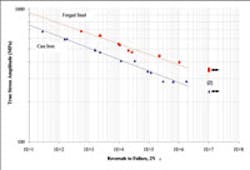Study Shows Superiority of Forged Crankshafts
The study compared the performance of a forged steel crankshaft, weighing 3.9 kg, versus a comparable cast-iron crankshaft, 3.7 kg.
Click image to enlarge
In a recent study conducted by the University of Toledo, forged-steel crankshafts were shown to have 36% higher fatigue strength than cast-iron crankshafts. That advantage could be expected to result in a product service life six times longer for the forged product. The study explored strength, ductility, and impact toughness of the two materials and found forged steel to be superior to the ductile cast iron in these qualities, as well.
Prof. Ali Fatemi led a research team for the Forging Industry Educational and Research Foundation (FIERF) and the American Iron and Steel Institute (AISI), which compared test results with two crankshafts in machined conditions, as shown in the accompanying photos.
“A crankshaft experiences a large number of load cycles during its service life. Therefore, fatigue performance and durability are key considerations in this component’s design and performance,” said Prof. Fatemi.
Another aspect of the study was the design optimization of the forgedsteel crankshaft. The dimensions and geometry of the crank webs were changed while maintaining dynamic balance, resulting in an 18% weight reduction. This optimally designed crankshaft was found to have no degradation in performance. The weight reduction of a rotating engine component is important, as fuel-efficiency improvements will be realized by the vehicle and the consumer.
“This study continues to prove to powertrain design engineers that forged steel outperforms other materials in critical safety component applications,” stated David Anderson, director of AISI’s Long Product Market Development Group.
Testing details
In comparing the forged steel and cast-iron crankshafts, Prof. Fatemi used crankshafts taken from a onecylinder four-stroke engine, typical of those used in riding lawnmowers. Fatemi concluded that as crankshaft performance parameters are similar to those of automobile crankshafts, the test results are relevant to automotive application design, as well as marine, mining, aircraft, farm machinery, and other industries that use internal combustion engines.
“In testing automotive crankshafts, researchers typically analyze single-throw components regardless of the final part size. Further, the analyzed section in this study closely resembled those in automotive crankshafts,” Fatemi said.
Superior durability was shown for the forged-steel crankshaft, as tests revealed slower crack growth on the steel crankshaft than on the cast-iron crankshaft.
Fatemi noted during the crankshaft testing that the crack growth life for both crankshafts was a significant portion of the fatigue life.
The researchers also studied forged-steel and cast ductile-iron materials themselves, making it possible to compare data without the effects of design parameters. He tested the fatigue resistance of the two materials and found that the forged steel had a 36% higher fatigue resistance than the cast iron, resulting in a 30 times longer life of the forged-steel material.
In monotonic tensile tests of the two materials, the research team found that the forged-steel material had significantly higher strength and ductility than the cast-iron material. In fact, the yield strength of the forged steel was 52% higher than that of the cast iron and the ultimate strength of the forged steel was 26% higher than the competing material.
Further, the forged steel was shown to have more ductility than the cast iron, as shown by the percent of reduction in area, which was 58% for the forged steel and six percent for the ductile cast iron.
Finally, the forged-steel material was shown to have significantly higher impact toughness than the ductile cast iron. When researchers studied the impact toughness of the two materials at various temperatures, they found that forged steel fared better by as much as nine times.
